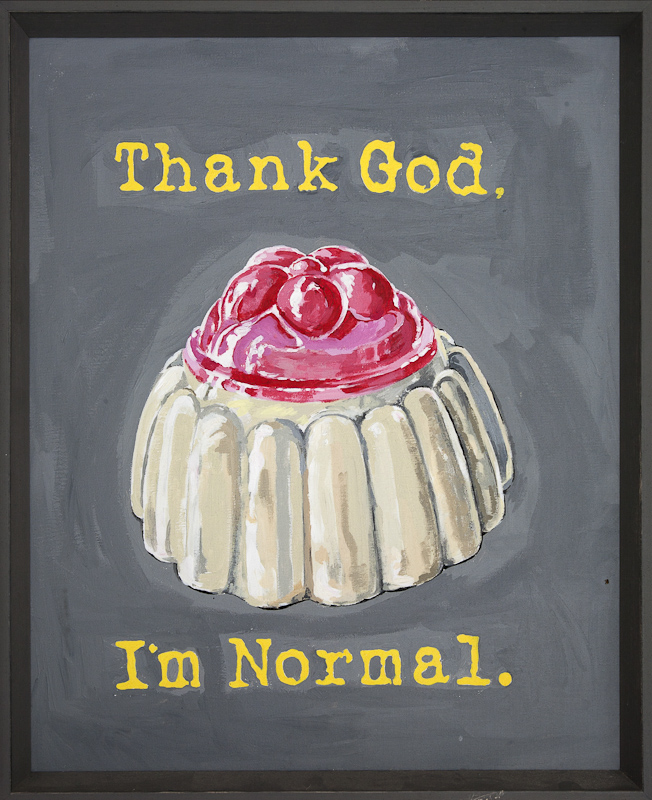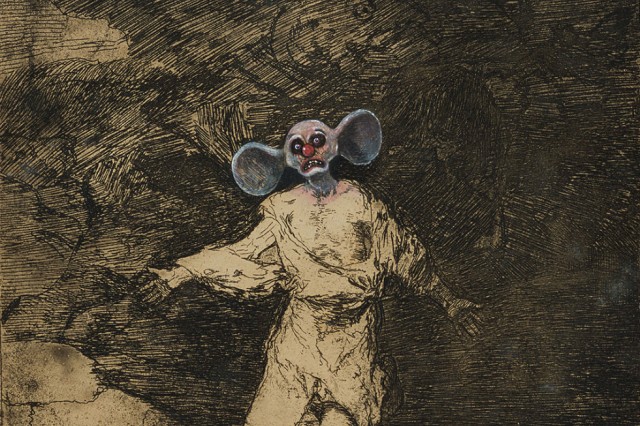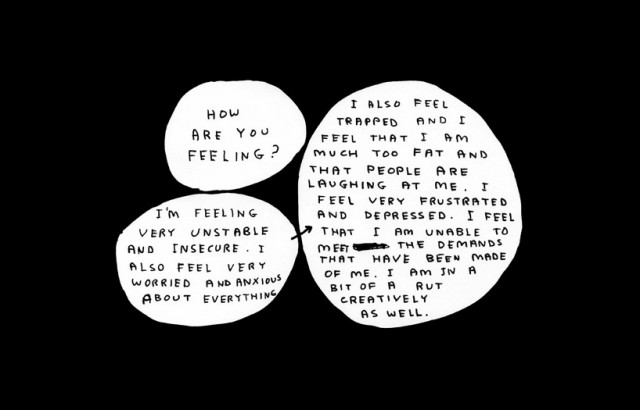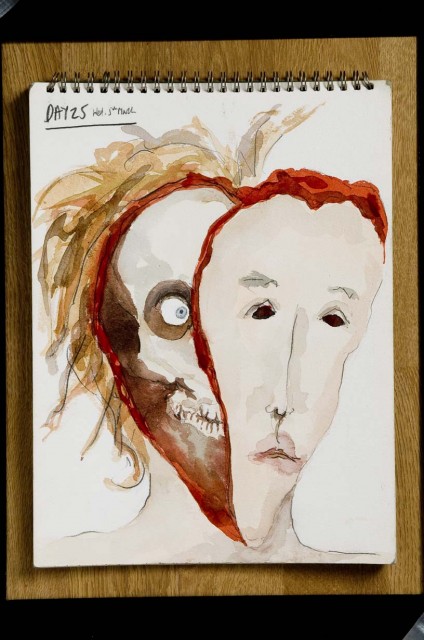People Never Notice Anything

Featuring dysfunctional cartoons from David Shrigley and a host of other provocative and sensitive artworks tackling our ideas of mental health, Broken Grey Wires’ highly anticipated first major exhibition is finally opening this week. Mike Pinnington catches up with the project’s artist/founder Lizz Brady for a candid interview about the challenges she’s faced and overcome in order to get to this point …
The Double Negative: We last spoke a little over a year ago – what’s happened/changed since?
Lizz Brady: I had to scale down the Broken Grey Wires project due to personal ill mental health, and working pretty much alone left me no time to create my own artwork. I have to keep stopping, stepping back and thinking hard about what Broken Grey Wires is, and how it can be achieved. I think I have realised things take longer than expected and I need to be patient and realistic.
The major exhibition in London, People Never Notice Anything [12--26 January at Guest Projects], had to be postponed for almost a year due to a failed funding application, which was difficult as the voices I hear were quick to tell me it was a reflection of my own abilities. But after a lot of hard work, the funding application was successful and we’ll open the exhibition on Thursday. This is exciting and scary at the same time!
The steering board has been increased, with new members being from all over the UK. This gives Broken Grey Wires a bigger demographic and more opportunity to expand.
I also had to ensure that I find time to make my own work, and have had lots of exhibitions around the world this year, which is a big positive as I gain more experience.

How has Broken Grey Wires been received?
Really well. Obviously, at the beginning of this journey I was able to get some incredible artists on board, like David Shrigley and Jake and Dinos Chapman [pictured, above]. Moving forward, I have made contacts with organisations such as Mind, Everton in the Community, and the Scottish Mental Health Art and Film Festival. There is also a huge following on social media, with engaging and honest discussions taking place.
It really has been an incredible few years and I have learnt so much from so many people.
You’ve said previously that Broken Grey Wires grew out of you writing down ideas and artists you wanted to work with. How did you get from that ideas phase to where you are today?
At first, I wrote to each artist, explaining why I wanted to work with them and how I thought their work would fit in with the show. As said before, everyone was interested and happy to be part of this.
As time went on, I realised that Broken Grey Wires could be something bigger than one exhibition and started to make connections with similar organisations. Again, just contacting them, beginning a line of communication, being open and honest about my own mental health and why I thought we could work well together.
I think being so open about things has helped, it personalises the situation. One in four people have had mental health issues, or know someone who has, so most people I get in touch with have probably got some connection to mental health, and I think (and hope) people just want this to succeed!

Where does the title of your first major exhibition – People Never Notice Anything – originate?
It is a quote from the book Catcher in the Rye [1951, J. D. Salinger]. It’s my favourite book, and one I often read when I am unwell. I took it with me when I was in hospital, and I read it over and over again. I have just had a show at Islington Mill [Manchester] and the title was also a quote from the book… “Liberate yourself from my vice like grip.” Maybe all my exhibition titles will be quotes!
Your 15 exhibiting artists, including the names already mentioned, make for an intriguing melting pot of approaches around the theme of mental health. Out of all of the artists — yourself, Jeremy Deller, Stuart Semple, Bo Christian Larsson, Marcia Farquhar, Augustus Veinoglou, Beagles and Ramsey, Magda Archer [pictured, top], The Vacuum Cleaner, David Sherry and Bobby Baker — would you describe, in your own words, one or two of the stand-out artworks?
Shrigley’s How Are You Feeling [2006, pictured above] is one of my favourite pieces of work. The handwriting style but especially the words, which are important to me. I remember the first time I read them and thought he had written the work especially for me. I think it reminds me that a lot of people can relate to feeling “much too fat”, and “unstable and insecure”.
Bobby Baker’s [pictured, below] diary drawings are very important to me. While at university and very poorly, I discovered her work and was mesmerised. I even wrote a third of my dissertation about her. I began to create my own diary drawings and they really helped me cope with unwanted thoughts, and to communicate with therapists.

What has the curatorial process been like, and what unites the artists in the show?
The curatorial process has been difficult; I’ve never curated such a big or important show, so I am feeling the pressure. I’m trying to take inspiration from the smaller exhibitions I have curated, which were all successful, and just believe in myself (!). I have some amazing help from artist Kirsty Harris, who is helping me with curatorial decisions. Without her I would be a mess, I’m sure.
All the artists are united by the fact they are there due to inspiring me in some way. I chose these artists due to loving their work and being motivated by them, to keep pushing myself.
We’ve spoken previously about how mental health issues remain somewhat off-limits, being difficult for people to comprehend and deal with. Are things improving?
I think so, yes. I recently read an article about how the music industry has helped improve discussions about mental health, and it is true. Some big names have come out to talk about their anxiety, PTSD, depression and eating disorders. For fans to see this, will hopefully mean they feel they can discuss their own mental health difficulties and it goes a long way to normalise the subject.
What makes art such a good space for conversations about mental health to take place?
I think the art world is pretty open about mental health too, with lots of exhibitions focusing on it, or raising money for mental health charities. It is encouraging to be around people who are so open and honest and really makes me want to keep moving forward with Broken Grey Wires to make it even better.
What’s next for Broken Grey Wires as a continuing project?
Good question! After the January exhibition I think I will take a little break. I’ve been working so hard for over two years, to get to this point, plus it will be nice to focus on making some new work.
After that? I need to sit down and figure out where to take it. New artists? New exhibitions? Tour the current exhibition around the UK? All questions that need to be asked. I will meet with the steering board to get input and opinions and will go from there.
One thing is certain though, I will be pushing the project into places which will develop and enhance the core ethos, to be different and approachable, and to be weird and wonderful.
Mike Pinnington
See People Never Notice Anything from Thursday 12 January 2017, 6—9pm, at Guest Projects, London – FREE. Exhibition continues until Thursday 26 January – contact Guest Projects for opening times
Images, from top: Magda Archer, Jake and Dinos Chapman, David Shrigley, and Bobby Baker. Courtesy the artists
Read our first interview with Lizz, How Are You Feeling? Introducing: Broken Grey Wires, here





